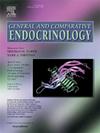三种促性腺激素释放激素基因在海马体中的鉴定与表达分析。
IF 1.7
3区 医学
Q3 ENDOCRINOLOGY & METABOLISM
引用次数: 0
摘要
促性腺激素释放激素(GnRH)通过下丘脑-垂体-性腺(HPG)轴对脊椎动物的生殖行为起着至关重要的调节作用。海马表现出独特的雄性怀孕行为,这使它们成为研究这种行为背后的调节机制的有趣对象。本研究以海马(Hippocampus erectus)为研究对象,获得了GnRH1、GnRH2、GnRH3三个GnRH基因的全长cDNA序列。值得注意的是,我们新发现了GnRH1,填补了之前研究中忽视该亚型的空白。通过同源分析,我们发现线状海马中GnRH1的核心肽在硬骨鱼中并不常见,而GnRH2和GnRH3的核心肽则是保守的。实时荧光定量PCR检测这些GnRH基因的组织表达模式。我们的研究结果表明,这三种基因主要在大脑中表达,尽管在不同的区域。其中GnRH1主要表达于下丘脑,GnRH2主要表达于视顶叶,GnRH3主要表达于端脑。表达动态显示GnRH2在性腺发育过程中逐渐减少,而GnRH3在性腺发育过程中显著增加,提示二者具有交替调节功能。此外,GnRH1和GnRH3在怀孕期间的表达水平明显高于孕前和孕后阶段,强调了它们在调节雄性海马怀孕行为中的关键作用。我们的研究结果为GnRH亚型在调节生殖过程中的复杂相互作用提供了见解,特别是在海马雄性怀孕行为的背景下。本文章由计算机程序翻译,如有差异,请以英文原文为准。
Identification and expression analysis of three gonadotropin-releasing hormone genes in the lined seahorse (Hippocampus erectus)
Gonadotropin-releasing hormone (GnRH) plays a crucial role in regulating reproductive behavior in vertebrates through the hypothalamus-pituitary-gonad (HPG) axis. Seahorses exhibit unique male pregnancy behavior, making them an interesting subject for investigating the regulatory mechanisms behind this behavior. In this study, we focused on the lined seahorse (Hippocampus erectus) and obtained the full-length cDNA sequences of three GnRH genes: GnRH1, GnRH2, and GnRH3. Notably, we newly identified GnRH1, filling a gap in previous research that had overlooked this subtype. Through a homologous analysis, we found that the core peptide of GnRH1 in lined seahorses is not common in teleosts, while the core peptides of GnRH2 and GnRH3 are conserved. Real-time PCR was performed to determine the tissue expression patterns of these GnRH genes. Our results showed that all three genes were predominantly expressed in the brain, albeit in different regions. Specifically, GnRH1 was mainly expressed in the hypothalamus, GnRH2 in the optic tectum, and GnRH3 in the telencephalon. Expression dynamics indicated a progressive decrease in GnRH2 and a significant surge in GnRH3 during gonadal development, hinting at an alternating regulatory function. Moreover, GnRH1 and GnRH3 expression levels were considerably higher during pregnancy compared to those in pre-pregnancy and post-pregnancy stages, underscoring their critical role in modulating male pregnancy behavior in lined seahorses. Our findings provide insights into the complex interplay of GnRH subtypes in regulating reproductive processes, particularly in the context of male pregnancy behavior in seahorses.
求助全文
通过发布文献求助,成功后即可免费获取论文全文。
去求助
来源期刊

General and comparative endocrinology
医学-内分泌学与代谢
CiteScore
5.60
自引率
7.40%
发文量
120
审稿时长
2 months
期刊介绍:
General and Comparative Endocrinology publishes articles concerned with the many complexities of vertebrate and invertebrate endocrine systems at the sub-molecular, molecular, cellular and organismal levels of analysis.
 求助内容:
求助内容: 应助结果提醒方式:
应助结果提醒方式:


